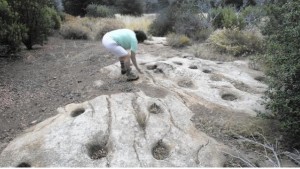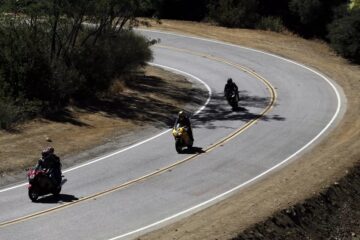Native American sites plundered in parks
‘Devastating’ looting hits Native American archaeological sites
Source of this article, the Los Angeles Times, August 16, 2015
State parks officials and Native American leaders are decrying what they say has been a devastating spate of vandalism and looting at historically and culturally significant sites in San Diego County’s backcountry.
At least five times in the past two years, looters have targeted American Indian archaeological sites within Cuyamaca Rancho State Park, authorities said.
At one site, 21 dig holes were found, each the size of a dinner table.
“I’ve seen some pretty looted sites across California, and that one was one of the worst I’ve ever seen, and it was one of the first ones we found,” said Dan Falat, superintendent of California State Parks’ Colorado Desert District, which includes Cuyamaca Rancho, Palomar Mountain and Anza-Borrego Desert state parks.

State parks archaeologist Robin Connors inspects a grinding hole at a village site in Cuyamaca Rancho State Park, where looting has been discovered.
At another archaeological site, not too far west of State Route 79, the remains of an ancient village had been plundered. That site features a huge slab of granite in which more than 40 bedrock mortars had been dug by generations of Kumeyaay women. Deep and cylindrical, the mortars — used to grind acorns — had been created over several centuries, with some up to 1,000 years old.
Authorities said that, at some of the locations, they’ve found shovels, screens, rakes and other tools that looters have used to dig up the earth and sift through soil to uncover arrowheads, other stone projectiles, and pieces of pottery.
The actions are criminal and in some cases could lead to felony charges of destruction of cultural resources, officials said.
Archaeologists say the damage is irreversible.
“Once you take it from where it is, it loses its context with the rest of the things that are found,” said park archaeologist Robin Connors. The artifacts “are all pieces of a puzzle, and once you take one piece out, it’s really irritating because you can’t find it again. It’s devastating, just devastating.”
Shasta Gaughen, the historic preservation officer for the Pala Band of Mission Indians, said the destruction is even worse from a cultural standpoint.
“For the Native American communities it’s basically grave robbing because you’re going into a sacred space and taking away the objects that were made by the ancestors,” she said. “Tribes believe those are things that should be left in place and they should be undisturbed. … It’s like you’re taking bodies from a cemetery.”
Falat said there are hundreds of archaeologically rich sites in Cuyamaca Rancho State Park and thousands more in Anza-Borrego, which has also been targeted by looters.
“To me this area of San Diego, from a cultural resources standpoint, is above anything you’d ever find in the state and probably the country,” Falat said.
The five recently looted sites — authorities asked that their specific locations be withheld — were discovered by “site stewards,” park volunteers who routinely check on culturally significant sites, photographing and making reports about each one.
Parks officials say the vandals are probably hobbyists and collectors rather than fortune hunters looking to sell what they find. Most arrowheads are worth only $3 to $5.
“It’s not a money-making venture,” Connors said. “It’s just that people are die-hard collectors.” She cited a case in the 1980s in which a man who had spent years illegally digging for arrowheads in the park was finally identified as a school counselor. In his house authorities found thousands of items, many that he had made into elaborate mosaics.
“There are people who just can’t stop collecting,” she said.
At the same time, the looting is organized and intentional, Connors added.
“It’s not just chance, people randomly stumbling upon things,” she said. “They’re coming up here with tools.”
The park service is employing high- and low-tech methods to try to identify the looters, including surveillance cameras, patrols and other investigative tools, said Falat, the parks superintendent. Park visitors are being encouraged to report any suspicious behavior they may see.
Depending on the site and what is taken, such thefts could lead to felony charges of destruction of cultural resources, theft of cultural resources, damage to state park land and disturbance of Native American remains.
I really want people to know that it’s illegal and there are consequences,” Connors said. “It’s not like in the past when boys and girls would go out arrowhead hunting.”
Falat reiterated that, to the American Indian community, the sites are irreplaceable.
“In many cases, this is all the history that is left,” he said.



0 Comments